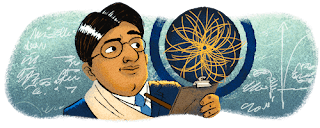Can you think of a student securing more than the maximum marks? If your answer is negative, then think again. Satyendra Nath Bose is an example of it.
 |
| Satyendra Nath Bose |
Satyendra Nath Bose Biography OR Wikipedia
Physicist Satyendra Nath was
born on January 1, 1894, in Calcutta (now Kolkata). His father Surender Nath
Bose was an employee of the East Indian Railway. He was the eldest of the seven
children in his family.
He was the only son of his parents as the rest were all daughters. His mother Amodini died in 1939, but Surender Nath took good care of his children. Surender Nath lived up to the ripe old age of 96, but ever alert and active.
Satyendra Nath
Bose was a brilliant student from the very beginning and always stood at the
top in his class. His love and interest in science were apparent from his
childhood. His exceptional intellectual powers were evident even in his school
days. The teachers soon became aware that Satyendra will in the future become a
great scientist and mathematician. He loved to improvise apparatus for his
school experiments and made a telescope by himself.
He joined the
Presidency College of Calcutta. There he found the company of some very
brilliant classmates including Meghnad Saha, J.N.
Mukherjee,
Nikhilranjan Bose, J.C Ghosh, etc. Some of them were destined to become
renowned scientists in the future. He was also very fortunate in the sense that
very illustrious teachers like J.C Bose, Prafulla Chandra Ray, and S.N. Maitra
were his teachers. During this period he also became acquainted with Subhash
Chandra Bose.
Satyendra Nath Bose Education
He obtained his degree at the age of 19 and completed the M.Sc. course in 1915. In 1916 only postgraduate courses in modern physics and mathematics were started at Calcutta University. He was appointed as a lecturer in physics the same year in the University.
Satyendra served
his alma mater in this capacity for five years from 1916 to 1921 and then joined
Dacca University. It was then that his short but very brilliant paper on “Max Plank’s
Law” and “Light Quantum Hypothesis” won him great fame and name.
He sent this
article to Albert Einstein who appreciated it so much as to translate it into
German and sent it for publication in a famous German Magazine. Bose went on
European Tour in 1924 and visited Paris, Berlin, etc.
In Paris, he
worked at Madam Curie Laboratory and then visited Paris and met Albert Einstein.
He met many
eminent scientists of Europe as well and held wide-ranging discussions on various
scientific topics. He was made professor of physics at the Dacca University in
1926. He worked there for about 25 years and won accolades.
In 1944 he was
elected President of the 31st session of the Science Congress. In 1945 he
became Kharia Professor of Physics at Calcutta University.
He retired from Calcutta University but was appointed Emeritus Professor after his retirement. Later he became Vice-Chancellor of the Vishvabharti University. In 1958 he was elected Fellow of the Royal Society, London.
Satyendra Nath Bose Awards
He was awarded an honorary D.Sc. degrees by many universities. His research papers were of great original value and was all published in international magazines of great repute. He enunciated many new theorems in geometry. His research and experiments influenced Einstein and they became intimate friends. Einstein himself translated some of these research papers in Germany and got them published, but when Einstein died in 1955, it shocked Satyendra Bose deeply.
Once he found some ancient coin molds in Haryana. He studied them and then came out with a master article entitled, “The Technique of Casting Coins in Ancient India” and it set a new standard of research on the subject.
Satyendra Nath Bose contribution to mathematics
Satyendra compared his findings with mathematical techniques of ancient Rome and China and concluded that the Indian technique was older and more sophisticated. He was awarded the Nelson Wright Medal in 1945 by the Numismatic Society of India. Professor Bose showed that photons had the property of being strictly identical, which led to the well-known Maxwell- Boltzmann statistics in respect of an assembly of photons and laid the foundation for quantum field theory. He also contributed to D2-statistics, Dirac equations and Zeeman Effect, Schrodinger’s wave equation for hydrogen, and the united field theory.



.jpeg)
